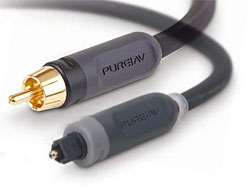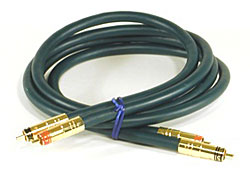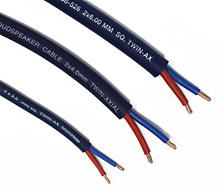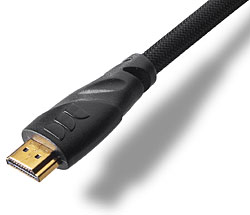Cables: The Tangled Web
 Digital audio cables
Digital audio cables
Digital audio cables carry data from the digital output of a source—such as the digital output of a DVD player—to an AV receiver or preamp-processor. Once there, it's converted to analog before being fed into your power amp—or the amplifier section of an AV receiver. A single digital cable nearly always carries more than one channel of information.
Digital cables designed for home use come in two varieties. Coaxial cables use metal conductors for the conductor and shield, and should be rated at a specific impedance—75 ohms—for best results. Optical digital cables use a fiber optic lead to relay data from source to receiver. The most common variety of optical digital interconnect is called Toslink (it was originally developed by Toshiba). Other varieties of optical cables are sometimes used in a few exotic, high-end audio products, but they are rare in home theater applications.
Arguments about which type of digital connection is superior have been going on for years, particularly in the audiophile world. Coaxial digital cables can generally pass a wider bandwidth signal than Toslink, and many audiophiles are firm in their belief that coaxial actually sounds better than optical.
Others say this is nonsense. Bits are bits, and both should sound the same. They also point out that optical, by omitting the metal link, minimizes the chances for ground loop hum.
You may very well not hear any difference between these two flavors of digital cable, but since no one that we know of has ever argued that coaxial sounds worse, we'd recommend a coaxial connection unless it results in hum—which in our experience it rarely does. If you run out of coaxial inputs, then use Toslink for your less critical sources. Some sources, in fact, offer only Toslink digital outputs.
 Interconnects
Interconnects
Interconnects carry relatively low level analog audio signals. They are used when you can't use a digital connection or choose not to, but need to route the audio between components such as a subwoofer, CD, or DVD player and the AV receiver. Since we're dealing with analog here, you'll need one interconnect for each channel. Interconnects are also used to connect a preamp-processor to power amps in a system that uses separates instead of an AV receiver.
The most common variety of interconnects are single-ended (unbalanced). They generally consist of a length of coaxial cable, which in its simplest form consists of a single center conductor surrounded by a shield, plus insulation. The ends are usually terminated with RCA-style phono plugs. Balanced interconnects, which have three leads inside the cable jacket, are sometimes used in expensive systems with separate preamp-processor and power amps. Balanced cables are less prone to noise pickup and hum in longer lengths.
 Speaker cables
Speaker cables
Speaker cables carry higher levels of current than interconnects, and are designed to transfer it as efficiently as possible from the AV receiver or power amplifier to the speakers. This is generally done with a single two-conductor cable (plus and minus) per speaker. There are exceptions to this, notably in a technique called bi-wiring, but that's a complication for another time.
The most important characteristic of a speaker cable is its resistance. This is determined by its thickness, material, and length. Most speaker cables are made of high quality copper. While there are no hard and fast rules as to the optimum cable thickness, we recommend avoiding any cables less than 16 gauge for even the shortest speaker runs. That eliminates the tiny 22 or 24 gauge stuff widely sold as "speaker cable." (The higher the gauge of a wire, the thinner it is.)
We recommend keeping speaker wires as short as possible, and recommend 12 gauge wire for runs of up to 25 feet or so. However, if your multichannel listening will be limited to movies, with your music listening largely two-channel, 16-gauge should work fine for the surround channels if they are located at a reasonable distance from the amps (25-30 feet).
If you must use longer cable runs to the front channel speakers, consider 10 gauge or thicker.
Do Different Cables Sound Different?
We happen to take the position that they do, but you'll find plenty of arguments on both sides. If you're just starting out, our advice is to avoid both the cheapest cables and going overboard on your cable budget.
For a 5.1-channel system with reasonable cable lengths, you're not likely to get burned one way or the other if you stick with well-known manufacturers and shop in the $50-100/meter range for a pair of interconnects or digital cables, and $500 for all your speaker cables. If that's too much, go cheaper if that's what's needed to allow you to afford the system you want without downgrading. Good audio cables can make a difference, but that difference is always far more subtle than the difference between, say, two sets of speakers.
You can always upgrade cables later, and here's something to consider when going down that path. Be suspicious of expensive cables that sound tonally different than what you had before. Not all sonic differences are improvements, and some cables are engineered to produce a pleasing sound, not accurate sound.
There's another consideration when cables are buried in the wall in a custom installation. In that case you might want to move up a grade or two at the outset to prevent later problems—problems that would require tearing into the walls!
 HDMI
HDMI
We'll restrict our discussion of Video Cables to the newest kid in town: HDMI. HDMI provides the highest quality video available to the consumer today. It can also carry audio along with the video.
We are referring here to the HDMI cable itself, not other concerns such as whether or not two HDMI-ready components can work together properly, which is not affected by the cables used.
Since it passes a digital video signal, HDMI is not subject to the progressively greater deterioration that can happen to analog video at increased cable length. Issues such as loss of resolution, poorer black level, reduced contrast, and degraded color performance simply do not occur with HDMI cables.
We've only seen two failure mechanisms in HDMI cables. First, there's no picture at all. Second, an HDMI cable can sometimes pass the image but also add on-screen noise in the form of snow-like sparkles, sometimes in pretty colors. Whether either of these problems occur depends on the cable's construction, its length, and, to a certain degree, the resolution of the signal passing through it.
Signal delivery from an HDMI cable is typically restricted mainly by cable length. We've never experienced a problem with any well made, properly functioning HDMI cable at a length of 5 meters or less. If you need to go much longer than that, cables using heavier wire are available, and are rated for longer runs.
There are also devices called repeaters. These small, signal-powered devices can be used to daisy chain two or more lengths of HDMI cables for a longer run. HDMI cables can be purchased that use repeater/boosters in the cable itself. If you're going to use lengths greater than 10-12 meters you should certainly look into a cable with a booster/repeater.
And, if you have a potentially difficult installation, involving long cable runs and high-resolution images, make sure you also have return privileges on any HDMI cable you buy.













































